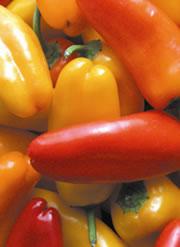 Hot stuff: chillies have been a part of our diets for longer than we thought.Linda Perry
Hot stuff: chillies have been a part of our diets for longer than we thought.Linda PerryWhen it comes to cuisine, some traditions are sacred. A Thai curry, for example, should be spicy enough to make your eyes water and your nose run. The heat from Korean kim chi simply must sizzle your tastebuds and leave you gasping for relief. Now archaeologists have found that New World farmers may have established blistering traditions like these much earlier than we thought.
According to an analysis published today in Science1, farmers in the Americas domesticated the chilli pepper more than 6,000 years ago. In some regions the desire for its flavour even predated the use of pottery.
Although they are vital for many traditional dishes around the world, chilli peppers are relative newcomers to the global culinary scene. The fiery crops originated in the Americas and didn't spread elsewhere until after Christopher Columbus had crossed the Atlantic.
But in their birthplace, the New World, it seems that people have been partial to spice for millennia. It is unclear what recipes they might have concocted — although given that their use predates pots and bowls, they may have been eaten raw at first.
Researchers led by Linda Perry, an anthropologist at the Smithsonian National Museum of Natural History in Washington DC, have found evidence of chilli cultivation at sites ranging from the Bahamas to the northwest corner of Peru. The oldest sites with evidence of domesticated chillies are in Ecuador.
Mystery food
The chilli leftovers were discovered by accident. For years, scientists had been finding microscopic grains of starch that they could not identify at archaeological sites around the Americas. The starch grains were clearly from plants, but did not match any of the usual suspects such as maize or squash. No one thought to check for chillies, says Perry, because everyone assumed early farmers would have focused on food staples. "It was quite a surprise because it was a plant being used as a spice rather than a staple," she says.
“The first person that bit into one of these peppers would have been in a lot of pain”
Paul Bosland, New Mexico State University
Archaeologists can be forgiven the mistake as they have had little opportunity to gain experience with chilli peppers, Perry adds. Ancient food crops often show up as charred remains left by a cooking fire, but chefs were unlikely to drop a chilli into the fire — not more than once, at least. Many species of chilli release an acrid smoke when burned, quickly turning a peaceful meal into a coughing fit.
Meanwhile, some plants leave behind small, durable silica microfossils, but chilli peppers don't make them. And pollen — which is often used to trace plants back through history — does not preserve well in the tropics.
But starch grains embedded in grinding tools and encrusted onto cookware have provided a new way of reconstructing prehistoric recipes, because the size and shape of preserved starch grains can be characteristic of a specific group of plants. Perry found that each of the five different species of modern cultivated peppers — members of the genus Capsicum — produce starch grains that are larger than grains from their wild relatives.
Armed with that knowledge, Perry looked back at the mysterious starch grain samples and realized that they were from domesticated chillies. Her next step will be to study samples from older sites, in the hope of tracking down intermediates between wild and domesticated chillies. Those intermediates will indicate exactly when and where cultivation began.
Stoneware
Over 6,000 years ago, the oldest site — the dry, forested Real Alto settlement in Ecuador — would have been a small village of mud and wood houses covered with thatched roofs, says Perry's colleague Deborah Pearsall, an anthropologist at the University of Missouri, Columbia. Now, all that's left of those houses are the mounds on which they stood.
Ecuadorian farmers had been growing key staples like squash and maize for at least 1,000 years before Real Alto cooks pounded their food with stone utensils, forcing starches into cracks in the stone and leaving clues to their spicy diet behind.
ADVERTISEMENT
People had suggested that chillies were domesticated as long as 6,000 years ago, but no one had been able to prove it, says Vaughn Bryant, who studies ancient food plants at Texas A&M University in College Station. He suggests that ancient cultures might have traded domesticated peppers in the early days of agriculture. "Peppers were just another good commodity," he says.
Chilli pepper cultivation will always hold a little mystery, says Paul Bosland of New Mexico State University's Chile Pepper Institute in Las Cruces, because no one can explain why we persevered with the eye-watering effects of eating them. "The first person that bit into one of these peppers would have been in a lot of pain," he says. "So you have to wonder why humans kept going back to them. But we do, again and again."
Visit our newsblog to read and post comments about this story.
